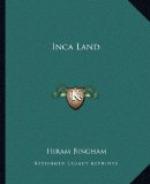Speaking of horticulturists reminds me of their enemies. Uru is the Quichua word for caterpillars or grubs, pampa means flat land. Urubamba is “flat-land-where-there-are-grubs-or-caterpillars.” Had it been named by people who came up from a warm region where insects abound, it would hardly have been so denominated. Only people not accustomed to land where caterpillars and grubs flourished would have been struck by such a circumstance. Consequently, the valley was probably named by plateau dwellers who were working their way down into a warm region where butterflies and moths are more common. Notwithstanding its celebrated caterpillars, Urubamba’s gardens of to-day are full of roses, lilies, and other brilliant flowers. There are orchards of peaches, pears, and apples; there are fields where luscious strawberries are raised for the Cuzco market. Apparently, the grubs do not get everything.
The next day down the valley brought us to romantic Ollantaytambo, described in glowing terms by Castelnau, Marcou, Wiener, and Squier many years ago. It has lost none of its charm, even though Marcou’s drawings are imaginary and Squier’s are exaggerated. Here, as at Urubamba, there are flower gardens and highly cultivated green fields. The brooks are shaded by willows and poplars. Above them are magnificent precipices crowned by snow-capped peaks. The village itself was once the capital of an ancient principality whose history is shrouded in mystery. There are ruins of curious gabled buildings, storehouses, “prisons,” or “monasteries,” perched here and there on well-nigh inaccessible crags above the village. Below are broad terraces of unbelievable extent where abundant crops are still harvested; terraces which will stand for ages to come as monuments to the energy and skill of a bygone race. The “fortress” is on a little hill, surrounded by steep cliffs, high walls, and hanging gardens so as to be difficult of access. Centuries ago, when the tribe which cultivated the rich fields in this valley lived in fear and terror of their savage neighbors, this hill offered a place of refuge to which they could retire. It may have been fortified at that time. As centuries passed in which the land came under the control of the Incas, whose chief interest was the peaceful promotion of agriculture, it is likely that this fortress became a royal garden. The six great ashlars of reddish granite weighing fifteen or twenty tons each, and placed in line on the summit of the hill, were brought from a quarry several miles away with an immense amount of labor and pains. They were probably intended to be a record of the magnificence of an able ruler. Not only could he command the services of a sufficient number of men to extract these rocks from the quarry and carry them up an inclined plane from the bottom of the valley to the summit of the hill; he had to supply the men with food. The building of such a monument meant taking five hundred Indians away from their ordinary occupations as agriculturists. He must have been a very good administrator. To his people the magnificent megaliths were doubtless a source of pride. To his enemies they were a symbol of his power and might.




